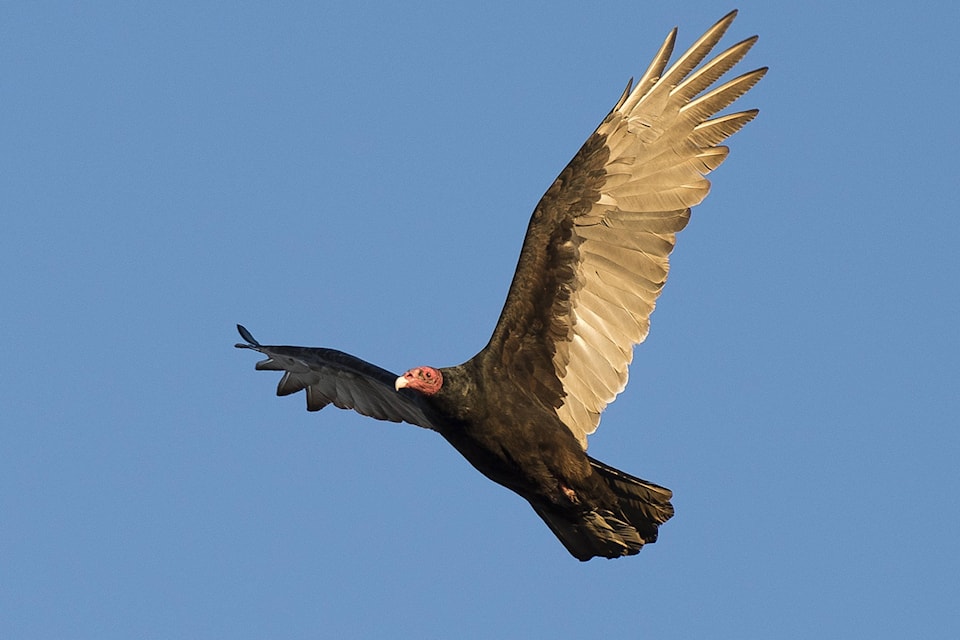Most of you have seen videos of scavengers in action, usually in Africa, where hyenas and various vultures completely devour the remains of an animal killed by some predator such as a lion.
What you may not know is that scavengers are also very common in the Okanagan Valley, although the remains they might be devouring aren’t so spectacular as a zebra or wildebeest.
Nevertheless, scavengers are very important in ecosystems around the world. Scavengers are animals that consume decaying animals or plants. They keep ecosystems free of dead animals and plants and break down the organic matter and recycle it into the ecosystem as nutrients. Many scavengers are omnivores (they eat both animals and plants) or carnivores — that is they will eat animals that they have hunted and killed themselves.
But some animals are strict scavengers — an example of this occurring in the Okanagan for part of the year is the turkey vulture. Turkey vultures have an extremely acute sense of smell so we often see them gliding about over the hillsides detecting decaying animals by the smell.
The bald eagle is often thought of as a top-line predator and indeed they are good hunters but they also are scavengers — they will readily eat animals and fish that have either died of natural causes or have been killed in some way. Some of the great gatherings of bald eagles are in the autumn at such places as Harrison Hot Springs, where the eagles come by the hundreds to feed on dead and decaying salmon. It is interesting to note that Benjamin Franklin was against the choice of the bald eagle as a symbol of “America” on their Great Seal because it often stole fish from osprey (technically this is a type of scavenging).
Other common animals in the Okanagan Valley that are at least part-time scavengers are coyotes, black bear, raccoons, crows, ravens, Stellar’s Jays, magpies, raccoons and all species of gulls. Without these scavengers, our riverbanks would be littered with decaying salmon carcasses, our beaches would be covered with dead fish and decaying plant material and the hillsides would certainly not be as clean as they are.
Unfortunately, many animals learn that scavenging around humans can be very profitable in terms of food, whether it be a grey jay at your campsite or a black bear in your garbage can. We are not doing the animals or ourselves any favours by allowing them to become dependent on scavenging from us. As they say in U.S. National Parks, “a fed bear is a dead bear.” Do not encourage animal scavenging from human sources.
On the other side of the coin, perhaps humans could learn something from the wild: scavenging is good for ecosystems. When I occasionally go to the Campbell Mountain landfill I am always appalled at the amount of good “trash’ that is being disposed of, from perfectly good-looking leather chairs (delivered to the landfill by a Cadillac SUV) to enough lumber every day to build a carriage house or a few dozen dog-houses or hundreds of bookcases. Many years ago, scavenging at landfills was allowed but I guess our litigious society has local levels of government afraid of being sued by someone who injures themselves while scavenging. What a shame! Scavenging, done right, could reduce the amount of trash by a significant amount.
The South Okanagan Naturalists’ Club meets the fourth Thursday of each month at 7 p.m. at the Penticton United Church. Our monthly meetings will resume in September. For details visit our website at www.southokanagannature.com. The public is welcome.
Bob Handfield is president of The South Okanagan Naturalists’ Club but the views expressed here are his own and do not necessarily reflect the views of the club. The South Okanagan Naturalists’ Club’s monthly meetings take place on the fourth Thursday of each month. Get all the details about our meetings and other activities at www.southokanagannature.com.
